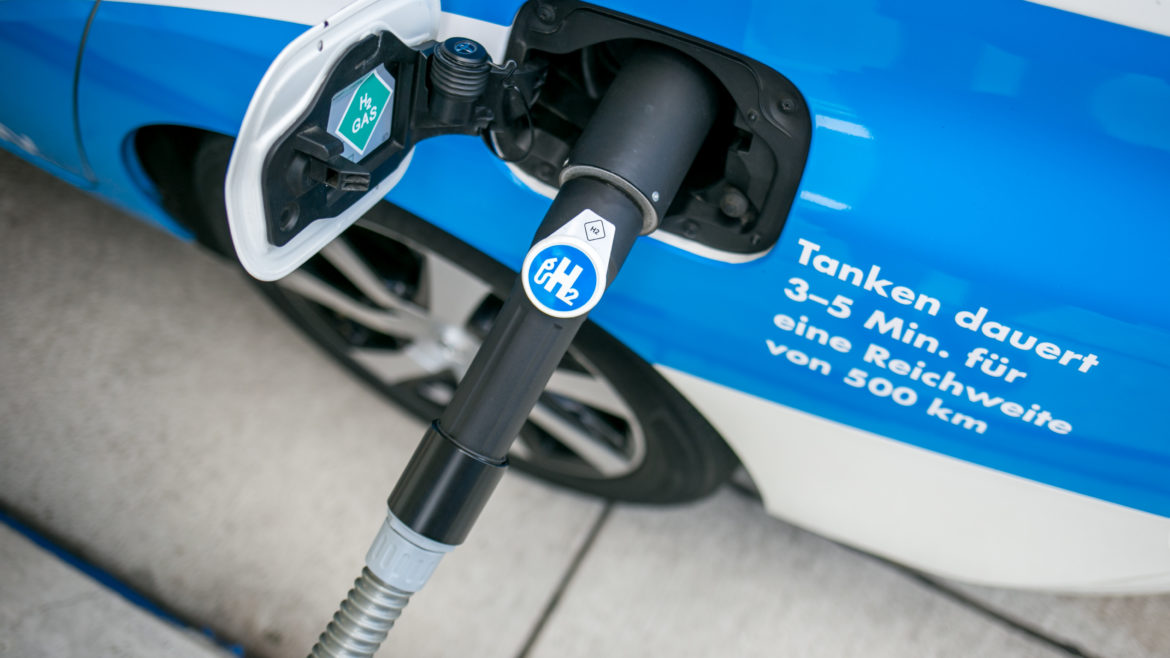Hydrogen – A technology for the future:
A beacon of hope for the energy transition
Hydrogen is a key building block for a successful energy transition. The German government’s climate protection plan envisages a reduction of 55% in carbon emissions across all sectors by 2030 compared to 1990. Due to its versatility, hydrogen has the potential to link the electricity, heat and mobility energy sectors and to ensure a sustainable and integrated energy system.


Green, blue and grey hydrogen
In the hydrogen economy, a distinction is essentially made between so-called green, blue and grey hydrogen.
Green hydrogen is the most sustainable hydrogen because 100% of the electricity used for electrolysis comes from renewable sources. This means that the hydrogen produced is CO2-free and thus climate-friendly.
Grey hydrogen is today produced in industry from the fossil energy carrier natural gas in a process known as steam reforming. In this process, natural gas is converted into hydrogen and CO2 under heat. Since CO2 is produced here, the production of hydrogen is not climate-neutral and increases the greenhouse effect.
Blue hydrogen is produced from natural gas in the same process as grey hydrogen. However, the CO2 arising from the hydrogen production process is captured and stored in geological reservoirs (carbon capture and storage, CCS). Since the CO2 is not released into the atmosphere, the production of blue hydrogen is considered climate neutral.
More information about the hydrogen colour gauge is available on the Federal Ministry of Education and Research website.
Hydrogen – multifaceted applications
Hydrogen, “H”, is by far the most common chemical element in the universe. On Earth, hydrogen is practically non-existent in its elemental form, but it is present in many compounds. In everyday life, we encounter hydrogen first and foremost in combination with the element oxygen “O”. Together they become water – “H2O”.
The process to separate hydrogen from oxygen is referred to as electrolysis. So-called electrolysers are technical devices that can separate water into hydrogen and oxygen with the help of electric current. One of the world’s largest hydrogen electrolysis plants is currently being built in Wesseling in North Rhine-Westphalia.
Mobility
Modern (engine-powered) mobility is electric. The fossil fuels of petrol and gas are finite and pollute the climate with excessively high CO2 emissions. As electric vehicles become increasingly popular on the market, they will gradually replace conventional internal combustion engines.
Electric mobility is the key technology for shaping a sustainable transport system. The electricity required by electric vehicles is provided either by batteries or fuel cells. The fuel cell converts hydrogen directly into electricity.
Battery or fuel cell-powered electric mobility not only affects our cars, but a wide range of means of transport, including:
- Buses: Run by private companies and public transport authorities alike. Hydrogen buses have already been in use in public transport for several years.
- Commercial and special vehicles: Trucks and vans of all sizes, emergency vehicles for the fire brigade, paramedics and other rescue services, but also tractors, forklifts, waste disposal trucks and many other vehicles can be powered by hydrogen.
- Trains: Initial practical trials with so-called hydrogen multiple units powered by electric motors are promising and show that hydrogen also has a future in rail transport. Hydrogen multiple units are already in regular service. Since 17 September 2018, two hydrogen trains from Alstom have been running on the route between Cuxhaven and Buxtehude via Bremerhaven and Bremervörde.
- Aircraft: Hydrogen can replace petroleum-based jet fuel. Aircraft can also be powered by hydrogen. After successful test flights, the first four-seater passenger aircraft, powered solely by a hydrogen fuel cell battery system was presented at its home airport in Stuttgart on 11 December 2020.
- Ships: Hydrogen and fuel cell technology can be used in the maritime sector for emission-free propulsion and for the on-board power supply.
Hydrogen: Key technology for sector coupling
Sector coupling connects the energy sectors of electricity, heat and mobility. It is considered a core concept for a successful energy transition. Its many uses as a storage medium and fuel make hydrogen a key technology for the energy transition.
Various concepts and technologies are suitable for coupling the sectors. The most promising approach today is the power-to-gas concept. Power-to-gas describes the generation of hydrogen or methane by means of electricity. The green hydrogen generated by renewable energies can then be stored and used in a variety of ways in all sectors.
- In transport: In combination with the fuel cell, hydrogen can be used as a fuel in almost all forms of mobility.
- In buildings: In apartments and houses, hydrogen can be used as an admixture or as a “synthetic natural gas” to help heat buildings.
- In industry: In the chemical industry, hydrogen forms the basis for many chemical value chains. For energy-intensive industries such as the metal processing industries or the cement industry, green hydrogen is the bearer of hope for a comprehensive decarbonisation of the industries.
- As energy storage: One of the great challenges of the energy transition is the storage of renewable energy. Hydrogen is an ideal energy storage medium. Rather than storing excess electricity in batteries, electrolysers can be turned on when needed to convert the electricity into renewable gas. Such green hydrogen can be very easily stored in pressurised tanks or, theoretically, in caverns. There are currently numerous projects and test projects underway to examine the storage of hydrogen in cavern storage facilities in salt rock.
Another major advantage of hydrogen is that it can be transported via the already existing and widely networked gas infrastructure throughout Germany and distributed equally to private households as well as industries alike.
Hydrogen via power-to-gas is the only technology available today that makes both seasonal storage of electricity and its use in all energy-intensive sectors possible.
Hydrogen Strategy of the Federal Government
A successful energy transition means balancing security of supply, affordability and environmental compatibility with innovative and intelligent climate protection. Hydrogen is a versatile energy carrier, energy storage medium and an essential element of sector coupling.
With the National Hydrogen Strategy , the German government is creating a holistic framework for action for the future production, transport, use and further application of hydrogen and consequently for corresponding innovations and investments. It defines the steps that are necessary to contribute to achieving the climate targets, to create new value chains for the German economy and to further develop international energy policy cooperation.


